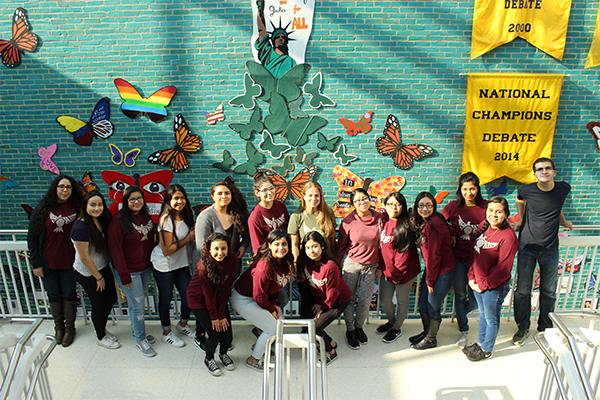SOAR butterfly display encourages inclusivity, awareness

SOARing Toward Equality: Posing in front of Students Organized Against Racismís (SOAR) art display in the old pit, SOAR members admire their hard work. SOAR created the display with the intent to raise awareness for the hardships experienced by immigrants, with members Annabelle Manjooran, Sana Bouacha and Debby Kim coming in during spring break to work on the project alongside junior Lesly Zavalaís leadership to turn the clubís vision into a reality.
April 21, 2017
South’s newly-created Students Organized Against Racism (SOAR) club created an art display in the Old Pit, accompanied by testimonies from both students and teachers on their personal experiences in order to raise awareness for and create empathy towards immigrants.
According to SOAR sponsor Emily Ekstrand, she saw a strong desire from students to raise awareness in school for the issue of immigration after the Day Without Immigrants on Feb. 16. Ekstrand said she received emails from students who participated by staying at home as well as those who came to school.
“We had a meeting that day,” Ekstrand said. “It was almost like an emergency meeting because [members] who hadn’t come to school came and we were all sitting and [asking] ‘How can we […] make immigrants and the children of immigrants feel like they are seen here at school?’”
She says the art display and the accompanying stories help people find common ground, even with those who seemingly are most different.
“I think so often immigration is seen as this black-and-white issue and people have very strong opinions about it on both sides, but I think that when you look at another person […] you see their humanity, whether it be that they have the same emotions that you do or the same family ties that you do,” Ekstrand said. “And isn’t that how you reach common ground? You tell someone about your life and they tell you about their life?”
While ideas of banners and posters arose, SOAR member Sana Bouacha suggested modelling the project after the blog Humans of New York (HONY). According to their website, “portraits and captions” serve as the subject matter and provide “daily glimpses into the lives of strangers.” Bouacha says they chose it as a guide for their own project because of the unique ways it conveys the subjects’ emotions.
“As I’m reading the stories and the quotes of the people [HONY] interviewed, […] I always felt what the person felt,” Bouacha said. “Actually, a lot of people I’ve talked to about [HONY] felt the same thing. […] I was able to empathize, I was able to understand [their perspective and] that’s why I wanted to bring that format into this project.”
Additionally, Ekstrand says that Monarch butterflies were chosen as the symbol for their project due to their connection with migration.
“[Monarch butterflies] migrate from Mexico to Canada every year and so it’s kind of a symbol of [the fact that] humans are animals [and will], like other animals, seek better living conditions,” Ekstrand said.
According to Ekstrand, junior Lesly Zavala especially wanted to bring attention to immigration. Zavala, who wrote her own testimony, says her story gives insight into the lives of immigrants.
“I want to share my story because I’m involved with people who aren’t minorities, and I feel like when they see me, they wouldn’t imagine me being somebody who goes through things like that,” Zavala said.
According to Ekstrand and ELL Coordinator Mina Moon, a number of teachers willingly came forward with their stories. Moon was among them.
“Sometimes students might feel like they’re alone, they might feel like, ‘I’m the only one [who] is struggling’ or, ‘I’m the only one whose […] families are concerned,’” Moon said. “But [….] when they see there is a wide spectrum of [people affected], it makes them feel like it’s okay to share their story and feel what you’re feeling.”
On April 13, SOAR hosted presentations on the project, followed by breakout groups for discussion. Zavala says this came about when Principal Lauren Fagel saw the mural and wanted to know more.
“[Having dialogue] humanizes the issue,” Zavala said. “We really want to […] make it hit [closer] to home and have people understand […] minorities go through this.”
For Bouacha, the project is especially personal due to her family’s background.
“My parents are immigrants […] from Morocco,” Bouacha said. “To have […] the image of immigrants portrayed so negatively, it breaks my heart. […] So I think […] my own goal [for] this project is to change that image.”


